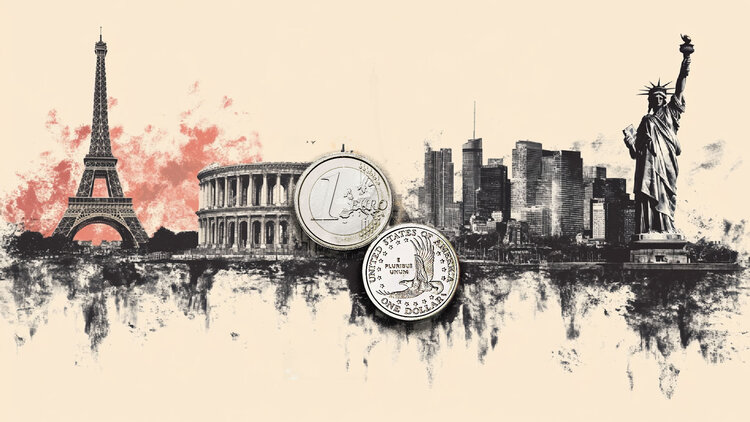- The euro remains modestly bid against the US Dollar on Friday, amid a softer Greenback and calmer risk tone.
- US President Trump’s cautious stance on the Israel–Iran conflict reduces fears of immediate escalation, weighing on safe-haven flows.
- The EUR/USD holds near 1.1510, slightly below the intraday high of 1.1535, while the DXY slips back under 99.00.
The Euro (EUR)edges up modestly against the US Dollar (USD) on Friday, capitalizing on a softer Greenback as traders digest a cautious geopolitical signal from the White House. US President Donald Trump’s plan to decide within two weeks on possible US involvement in the Israel–Iran conflict has calmed immediate fears of swift military action, slightly boosting risk appetite.
The EUR/USD pair remains near 1.1510 in a range-bound market on Friday, slipping slightly from the session high of 1.1535. At the same time, the US Dollar Index (DXY) remains under mild pressure, drifting back below the 99.00 handle to trade near 98.75, with sentiment subdued as markets stay on edge over possible US involvement in the Israel–Iran conflict.
The Philadelphia Fed Manufacturing Index held steady at -4.0 in June 2025, unchanged from May and missing market expectations of a milder decline to -1. The reading underscores that manufacturing activity in the region remains sluggish, weighed down by softening demand and early signs of cooling labor market conditions.
The ongoing Middle East conflict continues to roil global markets, driving Crude oil prices sharply higher and raising concerns about renewed inflationary pressures in the Eurozone. Notably, Eurozone headline inflation slipped to 1.9% in May from 2.2% in April, marking its first decline below the ECB’s 2% target in several months.
The European Central Bank (ECB) cut its key interest rate for the eighth time earlier this week and signaled it is approaching the end of its easing cycle. Speaking in Italy, ECB Governing Council member François Villeroy de Galhau noted that, barring a major external shock — including any fresh military escalation in the Middle East — monetary policy could still lean further toward accommodation over the next six months. He also pointed out that the euro’s recent strength against the US dollar should help cushion some of the inflationary impact from elevated oil prices.
On the US front, the Federal Reserve (Fed) kept its benchmark interest rate unchanged at 4.25%–4.50% for the fourth straight meeting earlier this week, sticking to its wait-and-see approach as policymakers weigh persistent inflation risks against signs of moderating economic momentum. Recent data showed headline inflation edging up slightly to 2.4% in May from 2.3% in April, while core inflation held steady near 2.8%, still above the Fed’s comfort zone.
While markets still expect the Fed to deliver two rate cuts this year, Fed Chair Jerome Powell cautioned that renewed cost pressures from tariffs or fresh Middle East tensions could complicate the path to easing. Despite this policy divergence, the Euro remains on the front foot for now, supported by ongoing tariff uncertainties.
Euro FAQs
The Euro is the currency for the 19 European Union countries that belong to the Eurozone. It is the second most heavily traded currency in the world behind the US Dollar. In 2022, it accounted for 31% of all foreign exchange transactions, with an average daily turnover of over $2.2 trillion a day.
EUR/USD is the most heavily traded currency pair in the world, accounting for an estimated 30% off all transactions, followed by EUR/JPY (4%), EUR/GBP (3%) and EUR/AUD (2%).
The European Central Bank (ECB) in Frankfurt, Germany, is the reserve bank for the Eurozone. The ECB sets interest rates and manages monetary policy.
The ECB’s primary mandate is to maintain price stability, which means either controlling inflation or stimulating growth. Its primary tool is the raising or lowering of interest rates. Relatively high interest rates – or the expectation of higher rates – will usually benefit the Euro and vice versa.
The ECB Governing Council makes monetary policy decisions at meetings held eight times a year. Decisions are made by heads of the Eurozone national banks and six permanent members, including the President of the ECB, Christine Lagarde.
Eurozone inflation data, measured by the Harmonized Index of Consumer Prices (HICP), is an important econometric for the Euro. If inflation rises more than expected, especially if above the ECB’s 2% target, it obliges the ECB to raise interest rates to bring it back under control.
Relatively high interest rates compared to its counterparts will usually benefit the Euro, as it makes the region more attractive as a place for global investors to park their money.
Data releases gauge the health of the economy and can impact on the Euro. Indicators such as GDP, Manufacturing and Services PMIs, employment, and consumer sentiment surveys can all influence the direction of the single currency.
A strong economy is good for the Euro. Not only does it attract more foreign investment but it may encourage the ECB to put up interest rates, which will directly strengthen the Euro. Otherwise, if economic data is weak, the Euro is likely to fall.
Economic data for the four largest economies in the euro area (Germany, France, Italy and Spain) are especially significant, as they account for 75% of the Eurozone’s economy.
Another significant data release for the Euro is the Trade Balance. This indicator measures the difference between what a country earns from its exports and what it spends on imports over a given period.
If a country produces highly sought after exports then its currency will gain in value purely from the extra demand created from foreign buyers seeking to purchase these goods. Therefore, a positive net Trade Balance strengthens a currency and vice versa for a negative balance.
Read the full article here


